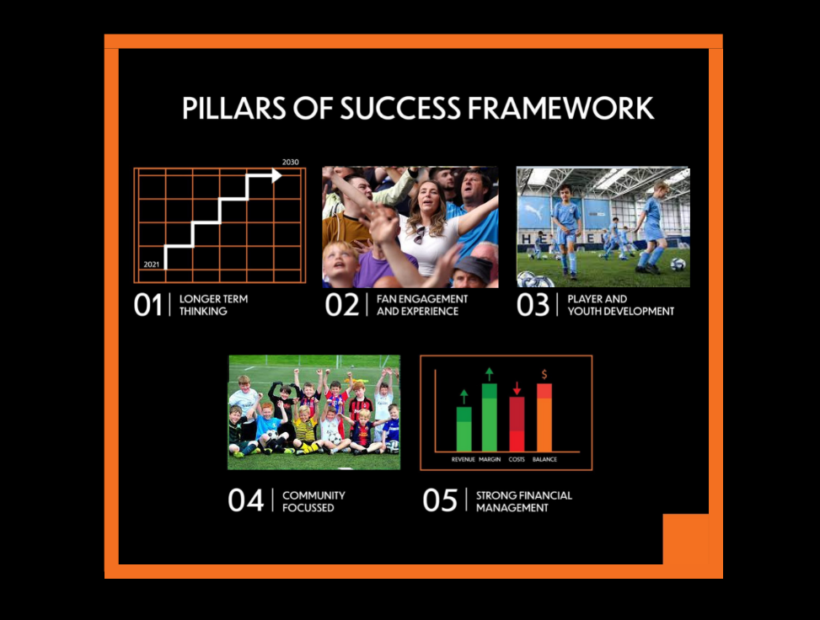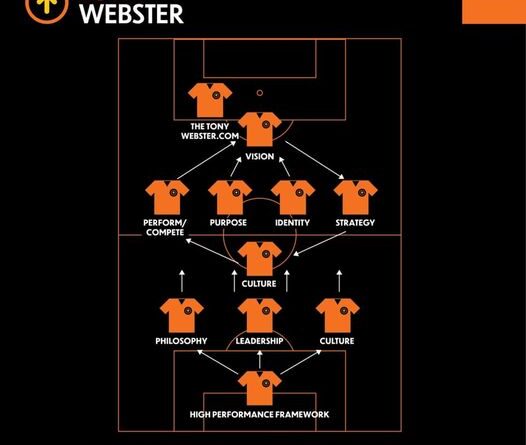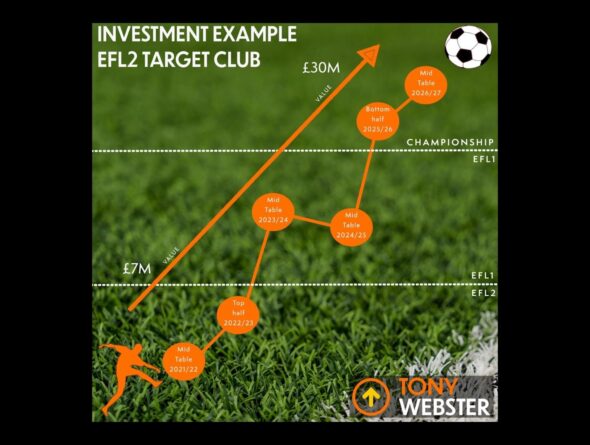HOW DO YOU TURN £1m INTO £5m or £10m INTO £35m?
We’re talking about the investment opportunity that is the business of football and how you build significant growth in asset value. Having looked at the ideal criteria for choosing which club to buy in my earlier blog and selecting a target club, it is important to be clear on the reasons behind the investment, the purpose of the investment and what success looks like.
What are you trying to achieve and what are the expectations in the short, medium and longer term? Is this simply promotions through the league or player development, or a wider commercial benefit in other sectors for the investor? Either way, the purpose for the investment needs to be very clear from the start, as this shapes everything that follows.
Once that is understood, there needs to be a vision of what the future position looks like and a detailed strategic plan developed to deliver that vision. I believe there are five core pillars of success within the business of football that should underpin this plan:
- Long term view and whole organisation approach
- Fan engagement and fan experience
- Player and Academy youth development
- Community and social purpose
- Strong financial management
Delving into each of these points a little deeper, firstly a long-term view and considering the whole organisation. It is essential to take this approach with planning and decision-making, rather than the typical short-term, quick win mentality that currently exists. Taking a 10+ years view allows for longer term planning and operational infrastructure to be put in place. The whole organisation approach is a key element within this longer term thinking and what I mean by that is building the whole club as one, rather than just focusing on one aspect, such as the first team.
Secondly, fan engagement and fan experience should be a priority. Fans are central to the club and should be taken with you on the journey. Communicating and over communicating with the fans the vision, the plan, progress to date and so on brings them closer and enables them to feel part of the progress. Focusing on the fan experience, especially on matchday, which includes such things as their final stages of the journey to the stadium, as well as whilst they are within the stadium. Frequently the fans are not considered as a priority, but by engaging with the fans and really understanding what it means to the fans, this can make a huge difference on all levels. This could simply be in attendance numbers or revenue from other match day and retail spend. But it also adds to commercial partnership value as increasingly these partners are looking for more than brand awareness.
When it comes to players, there is abundant evidence that you cannot just buy success through large budgets, buying players and hoping for quick success. There is an alternative and this is where player and academy youth development come in. By making your assets, namely your players into better players, the team will be better, resulting in more wins and progression up the league. It also brings a significant revenue stream, as the best players will undoubtedly attract offers from other clubs. A revenue stream which can be repeated and grown, whilst enjoying current on-pitch success. Benfica and Ajax are great examples and amongst the best of this model.
Focusing on player development seems an obvious thing to say, but the difference is in having coaches who’s focus is on improving players, making players into better players, rather than coaches who are focused on winning matches. This comes back to building from the ground upwards and consequential success follows.
Academy youth development fits alongside this and exactly what the best structure for youth development is, is dependent on the specific club and would need to be assessed and considered depending on what was available in that particular scenario. There is no clear evidence that one format of youth development is the best, with examples of category 2 and category 1 academies doing well, but also examples of clubs with no academy and operating a B team and under 23 model. A great example is Brentford, doing well in the league and generating significant income from players sales each year, an average of £30m per season for the last 5 season.
Next is the wider community within the city or town where the club plays. The club is the heart of the City and social responsibility should be a key factor. It is clear that football has the power to improve people’s lives, as well as their health and well-being and this should be embraced. The club should have a real social conscience and social purpose should run through the fabric of the club.
Lastly, strong financial management and controls is an obvious point to make, but within football this is often not the case. There is income and expenditure, with a budget to work to and there is no excuse when it comes to ensuring the club operates within budgets, works to a strategy and delivers profitability. Controlling the finances is fundamental to successful in any business and an absolute must in football.
Of course, there is more to it than a simple 5 step approach, but by using the my ideal club criteria and these pillars of success, the initial investment will see growth and profitability, offering significant return on investment to the investor over the longer term. Whilst these five core pillars underpin the success pathway, there are other aspects to consider which work alongside and overlay the core pillars to achieve sustainable success. These include a clear purpose and identity, understanding the club’s heritage and creating a sense of belonging for all. Consistent leadership is paramount and provides the glue that holds everything else together in any high-performance environment. Subsequent blog posts will dig deeper into each of these elements and how they contribute to the successful football club.



